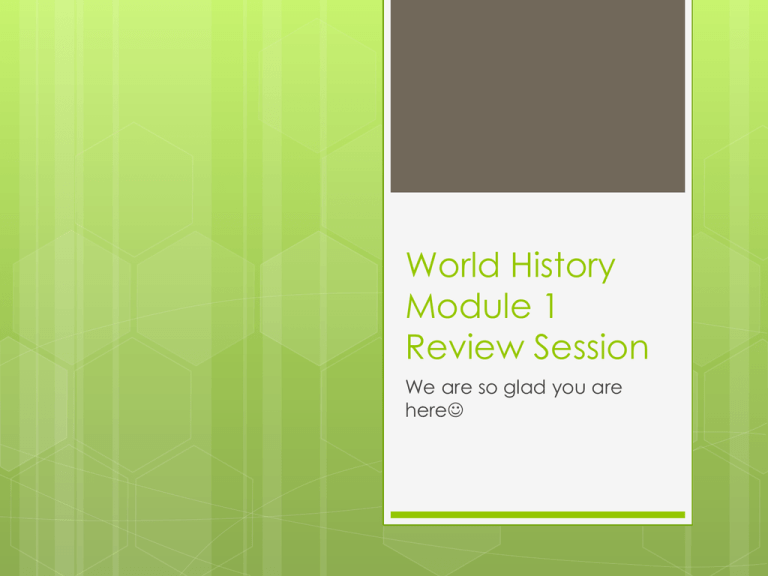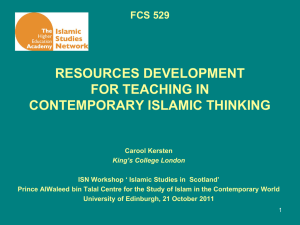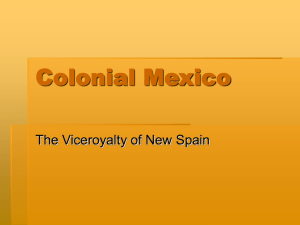01.03 MC
advertisement

World History Module 1 Review Session We are so glad you are here World History Live Lesson White Board Tools What do you remember about Module 1? Think about religion and empires Monotheistic Religions Judaism Islam Christianity Empires Roman Empire Byzantine Empire Ottoman Empire How to break down a test question (01.03 MC) SS.912.W.3.7: C h o i c e s What impact did the Frankish leader Charles Martel have on Christian Europe's relations with Muslim Spain in the eighth century? A. He negotiated a clear border between Spain and France. LC= Low Complexity MC= Moderate Complexity HC = High Complexity B. He stopped the Muslim advance from Spain into France. C. He welcomed ambassadors and scholars from Moorish Spain. D. He established a Christian kingdom in a corner of northern Spain. Stem How to break down a test question (01.03 MC) SS.912.W.3.7: C h o i c e s What impact did the Frankish leader Charles Martel have on Christian Europe's relations with Muslim Spain in the eighth century? A. He negotiated a clear border between Spain and France. LC= Low Complexity MC= Moderate Complexity HC = High Complexity B. He stopped the Muslim advance from Spain into France. C. He welcomed ambassadors and scholars from Moorish Spain. D. He established a Christian kingdom in a corner of northern Spain. Stem (01.04 MC) SS.912.W.3.6: Let’s Try Another one Which of the following describes the primary issue that divided Sunni and Shi'a Muslims in early Islam? A. The Sunni required a strict interpretation of the Qu'ran's prophecies. B. The Shi'a believed in a conquering Islam made from new territory. C. The Shi'a believed that only God could choose the successor to Muhammad. D. The Sunni believed that depictions of Allah were acceptable in some forms. (01.04 MC) SS.912.W.3.6: Let’s Try Another one Which of the following describes the primary issue that divided Sunni and Shi'a Muslims in early Islam? A. The Sunni required a strict interpretation of the Qu'ran's prophecies. B. The Shi'a believed in a conquering Islam made from new territory. C. The Shi'a believed that only God could choose the successor to Muhammad. D. The Sunni believed that depictions of Allah were acceptable in some forms. Judaism, Islam, and Christianity share a belief in A. the central authority of the Pope B. a prohibition of the consumption of port C. reincarnation and the Four Noble Truths D. monotheism and ethical conduct Judaism, Islam, and Christianity share a belief in A. the central authority of the Pope B. a prohibition of the consumption of port C. reincarnation and the Four Noble Truths D. monotheism and ethical conduct The Koran, Jihad, and the Hegira are most closely associated with the practice of A. Islam B. Judaism C. Shinto D. Buddhism The Koran, Jihad, and the Hegira are most closely associated with the practice of A. Islam B. Judaism C. Shinto D. Buddhism An influence that spread from the Byzantine Empire to Early Russia was the A. use of the Latin alphabet B. Orthodox Christian religion C. beginning of democracy D. factory system An influence that spread from the Byzantine Empire to Early Russia was the A. use of the Latin alphabet B. Orthodox Christian religion C. beginning of democracy D. factory system After the fall of Rome, the eastern portion of the Roman Empire became known as the A. Persian Empire B. Byzantine Empire C. Mongol Empire D. Gupta Empire After the fall of Rome, the eastern portion of the Roman Empire became known as the A. Persian Empire B. Byzantine Empire C. Mongol Empire D. Gupta Empire Which activity occurred during the Golden Age of Muslim culture? A. destruction of books containing Greek and Roman ideas B. beginning of pilgrimages to Mecca C. opposition to freedom of thought and to foreign ideas by rulers D. major discoveries in mathematics and science Which activity occurred during the Golden Age of Muslim culture? A. destruction of books containing Greek and Roman ideas B. beginning of pilgrimages to Mecca C. opposition to freedom of thought and to foreign ideas by rulers D. major discoveries in mathematics and science This map of Europe and the Mediterranean region was made in 1513 by Muslim cartographer Piri Reis, who lived in the Ottoman Empire. Use this map to answer the following question: What could a 21st century historian learn from this primary source? A. the extent of 16th century Islamic travel in of Europe and the Mediterranean B. the extent of 16th century Indian travel in Europe and the Mediterranean C. the degree to which borders between European countries have shifted D. ways in which Ottoman knowledge of geography was accurate and inaccurate This map of Europe and the Mediterranean region was made in 1513 by Muslim cartographer Piri Reis, who lived in the Ottoman Empire. Use this map to answer the following question: What could a 21st century historian learn from this primary source? A. the extent of 16th century Islamic travel in of Europe and the Mediterranean B. the extent of 16th century Indian travel in Europe and the Mediterranean C. the degree to which borders between European countries have shifted D. ways in which Ottoman knowledge of geography was accurate and inaccurate (01.04 HC) SS.912.W.1.3: The following text is excerpted from a ninth-century Muslim historian's description of the eighth-century Muslim conquest of Spain. Use this excerpt to answer the following question: Musa Ibn Nosseyr sent his son Merwan to Tangiers, to wage a holy war upon her coast. Having, then, exerted himself together with his friends, he returned, leaving to Tarik Ibn Amru the command of his army which amounted to 1,700. Others say that 12,000 Berbers besides 16 Arabs were with Tarik: but that is false. —excerpt from Idn Ab-del-Hakem, “The Islamic Conquest of Spain.” Why might the ninth-century historian's figure of 1,700 be questioned by modern historians? A. B. C. D. Historians were less accurate in the past than today. The text does not say where he got the figure. The historian was not one of the soldiers at the battle. The writer does not say that the figure is accurate. (01.04 HC) SS.912.W.1.3: The following text is excerpted from a ninth-century Muslim historian's description of the eighth-century Muslim conquest of Spain. Use this excerpt to answer the following question: Musa Ibn Nosseyr sent his son Merwan to Tangiers, to wage a holy war upon her coast. Having, then, exerted himself together with his friends, he returned, leaving to Tarik Ibn Amru the command of his army which amounted to 1,700. Others say that 12,000 Berbers besides 16 Arabs were with Tarik: but that is false. —excerpt from Idn Ab-del-Hakem, “The Islamic Conquest of Spain.” Why might the ninth-century historian's figure of 1,700 be questioned by modern historians? A. B. C. D. Historians were less accurate in the past than today. The text does not say where he got the figure. The historian was not one of the soldiers at the battle. The writer does not say that the figure is accurate. How do you break down a map? 1 3 At its point of greatest extent, in which regions did the Byzantine Empire hold territory? 2 A. Italy, Russia, and the west coast of Africa B. Spain, the Black Sea, and North Africa C. the Dnieper, Danube, and Rhone Rivers D. northern Europe and southern Africa How do you break down a map? At its point of greatest extent, in which regions did the Byzantine Empire hold territory? A. Italy, Russia, and the west coast of Africa B. Spain, the Black Sea, and North Africa C. the Dnieper, Danube, and Rhone Rivers D. northern Europe and southern Africa (01.03 MC) SS.912.W.3.3: Use the image of a Jewish cantor reading the Passover story in Islamic Spain to answer the following question: What does this image demonstrate about the policies of Islamic rule in Spain? A. Jews were forced to hide their religion and pray indoors. B. Jews were allowed to practice their religion in Islamic Spain. C. The Jews living in Islamic Spain were required to construct their synagogues along Islamic lines. D. The Jews living in Islamic Spain were greatly resented by practicing Christians. (01.03 MC) SS.912.W.3.3: Use the image of a Jewish cantor reading the Passover story in Islamic Spain to answer the following question: What does this image demonstrate about the policies of Islamic rule in Spain? A. Jews were forced to hide their religion and pray indoors. B. Jews were allowed to practice their religion in Islamic Spain. C. The Jews living in Islamic Spain were required to construct their synagogues along Islamic lines. D. The Jews living in Islamic Spain were greatly resented by practicing Christians. You got this!!!!! Remember call, text or email your instructor if you have any questions before the exam! We know you are going to rock your exam!!!!! BREAK OUT SLIDES Directions: STEP 1 – Group will divide up the Topics/Modules. STEP 2 - Each group member creates 1 question from their assigned topic using the provided template. Try to make a higher level question. STEP 3 – Each group member will fill out his/her portion of the answer key. STEP 4 - After all questions are created, the group will work together to create a one slide advertisement for their review . The advertisement should include graphics, topics covered, a title, and 2-3 sentences. STEP 5 – Groups will switch rooms and attempt the other group questions. Sign up for a question. Write your name by the question. Question 1 Question 2 Question 3 Question 4 Question 5 Question 6 Question 7 Question 8 Question 1 Question 2 Question 3 Question 4 Question 5 Question 6 Question 7 Question 8 Answer key 1. 2. 3. 4. 5. 6. 7. 8. Advertisement (Include graphics, topics, and write up)









